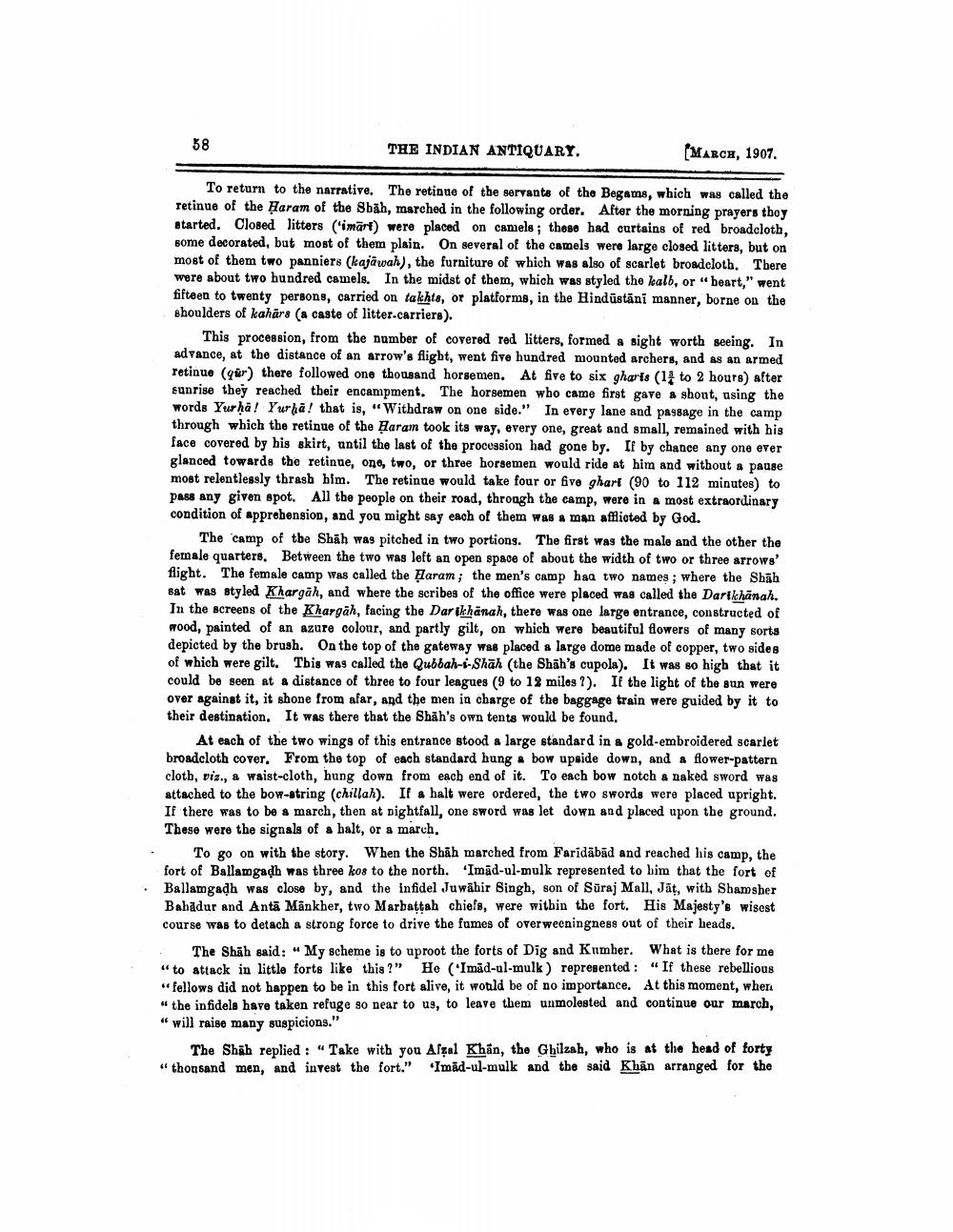________________
38
THE INDIAN ANTIQUARY.
MARCE, 1907.
To return to the narrative. The retinue of the servants of the Begams, which was called the retinue of the Param of the sbah, marched in the following order. After the morning prayers tboy started. Closed litters ('imārt) were placed on camels; these had curtains of red broadcloth, some decorated, but most of them plain. On several of the camels were large closed litters, but on most of them two panniers (kajāwah), the furniture of which was also of scarlet broadcloth. There were about two hundred camels. In the midst of them, which was styled the kalb, or "beart," went fifteen to twenty persons, carried on takhts, or platforms, in the Hindūstāni manner, borne on the shoulders of kahārs (a caste of litter.carriers).
This procession, from the number of covered red litters, formed a sight worth seeing. In advance, at the distance of an arrow's flight, went five hundred mounted archers, and as an armed retinue (qür) there followed one thousand horsemen. At five to six gharis (14 to 2 hours) after sunrise they reached their encampment. The horsemen who came first gave a shout, using the words Yurha! Yurha! that is, “Withdraw on one side." In every lane and passage in the camp through which the retinue of the Baran took its way, every one, great and small, remained with his face covered by his skirt, until the last of the procession had gone by. If by chance any one ever glanced towards the retinue, one, two, or three horsemen would ride at him and without a pause most relentlessly thrasb him. The retinue would take four or five ghart (90 to 112 minutes) to pass any given spot. All the people on their road, through the camp, were in a most extraordinary condition of apprehension, and you might say each of them was a man afflicted by God.
The camp of the Shah was pitched in two portions. The first was the male and the other the female quarters. Between the two was left an open space of about the width of two or three arrows' flight. The female camp was called the param; the men's camp haq two names; where the Shah Bat was styled Khargāh, and where the scribes of the office were placed was called the Dartkhanah. In the screens of the Khargāh, facing the Darikhanah, there was one large entrance, constructed of wood, painted of an azure colour, and partly gilt, on which were beautiful flowers of many sorts depicted by the brush. On the top of the gateway was placed a large dome made of copper, two sides of which were gilt. This was called the Qubbah--Shāh (the Shāh's cupola). It was so high that it could be seen at a distance of three to four leagues (9 to 12 miles ?). If the light of the sun were over against it, it shone from afar, and the men in charge of the baggage train were guided by it to their destination. It was there that the Shah's own tents would be found.
At each of the two wings of this entrance stood a large standard in a gold-embroidered scarlet broadcloth cover. From the top of each standard hung a bow upside down, and a flower-pattern cloth, viz., a waist-cloth, hung down from each end of it. To each bow notch a naked sword was attached to the bow-string (chillah). If a halt were ordered, the two swords were placed upright. If there was to be a march, then at nightfall, one sword was let down and placed upon the ground. These were the signals of a halt, or a march.
To go on with the story. When the Shāh marched from Faridābād and reached his camp, the fort of Ballamgadh was three kos to the north. 'Imād-ul-mulk represented to him that the fort of Ballamgadh was close by, and the infidel Juwāhir Singh, son of Suraj Mall, Jät, with Shamsber Bahadur and Antä Mänkher, two Marbattah chiefs, were within the fort. His Majesty's wisest course was to detach a strong force to drive the fames of overweeningness out of their heads.
The Shāh said: "My scheme is to uproot the forts of Dig and Kumber. What is there for me "to attack in little forts like this?" He ('Imăd-ul-mulk) represented : " If these rebellious "fellows did not happen to be in this fort alive, it would be of no importance. At this moment, wher "the infidels have taken refuge go near to us, to leave them unmolested and continue our march, " will raise many suspicions."
The Shah replied: "Take with you Afgal Khân, the Ghilzah, who is at the head of forty " thousand men, and invest the fort." "Imád-ul-mulk and the said Khan arranged for the




